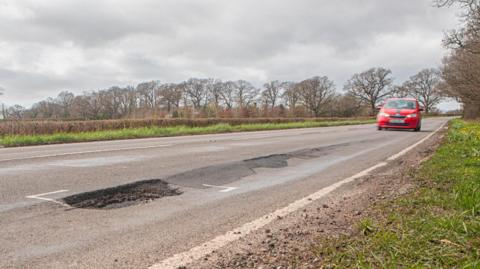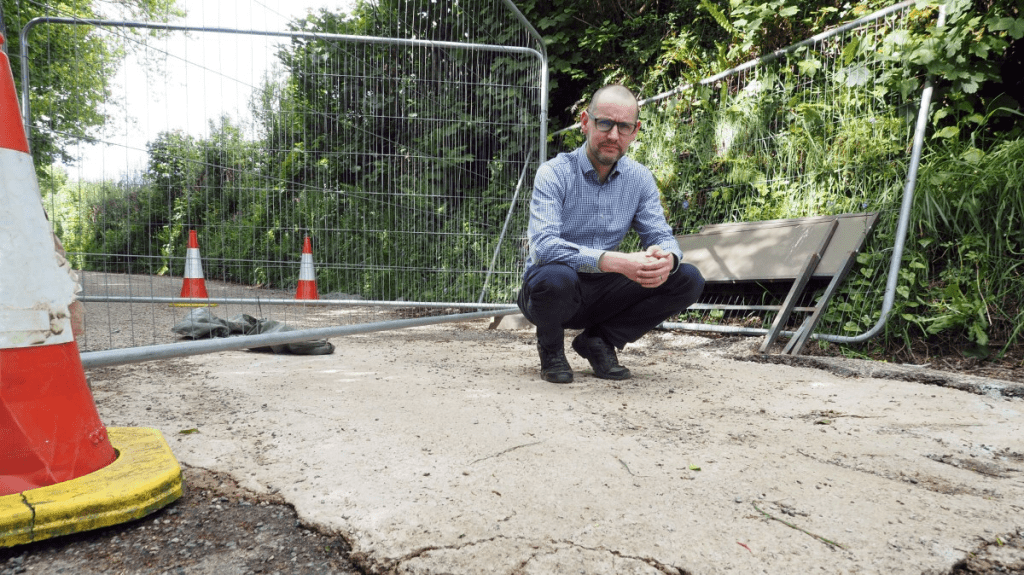A frustrated driver in Cornwall, England, took matters into their own hands after months of government inaction, filling a massive pothole that had made a local road nearly impassable. While the quick fix temporarily restored accessibility, it also sparked backlash from the company responsible for road maintenance. This act of defiance has fueled a broader debate about public infrastructure delays and whether citizens should intervene when officials fail to act.

The Pothole That Pushed a Driver Over the Edge
For months, residents of Tanhouse Road in Cornwall had been dealing with worsening road conditions. The road had been officially closed since April due to drainage issues, but no substantial repairs had been carried out. In the meantime, the pothole continued to grow, creating a hazard for motorists and pedestrians alike.
Despite repeated assurances from Cornwall Highways and Cormac, the private company responsible for road maintenance, no real progress had been made. For locals, the situation became a symbol of bureaucratic inefficiency—officials talked about solutions, but nothing ever got done.
Finally, one frustrated driver decided they’d had enough. Armed with cement, they filled the pothole themselves, making the road functional again. However, what seemed like a practical solution quickly turned into a controversy.
Officials Condemn the DIY Repair
While the anonymous driver’s actions won applause from some locals, they infuriated Cormac and local officials. Representatives from Cornwall Highways stated that unauthorized repairs could compromise future work, potentially leading to long-term structural issues.
Cormac also emphasized that roadwork requires proper expertise and safety measures, warning that the unauthorized fix might cause additional damage or even pose a legal risk if an accident occurred. Authorities launched an investigation to identify the person responsible, making it clear that such actions were “unacceptable and dangerous.”
The backlash raised an important question: If authorities had repaired the road in a timely manner, would this situation have even happened?

When Citizens Take Infrastructure Into Their Own Hands
This incident in Cornwall isn’t an isolated case. Around the world, frustrated residents have taken matters into their own hands when local governments fail to maintain public infrastructure.
- Toronto, Canada: A resident built a set of park stairs himself after the city delayed the project for years and estimated it would cost tens of thousands of dollars. His DIY solution cost only a fraction of the official price.
- United States: Communities across the country have filled potholes, repainted crosswalks, and refurbished public spaces after seeing prolonged government delays.
- UK and Europe: Similar cases have emerged where citizens, frustrated by slow-moving bureaucracies, have repaired roads, installed safety features, or cleaned up public spaces without official approval.
While these actions highlight inefficiencies in public infrastructure management, they also raise legal and safety concerns. Governments argue that roads, bridges, and other public assets need professional maintenance to ensure durability and compliance with safety standards.
The Case for Citizen-Led Repairs
Supporters of DIY repairs argue that when governments fail to act, people have no choice but to step in. After all, why should residents endure months—or even years—of hazardous conditions while bureaucrats push papers around?
- Bureaucratic Delays Waste Time and Money: Public works projects often get caught in layers of red tape, leading to excessive costs and unnecessary delays.
- Immediate Solutions Improve Safety: A pothole left unattended for months can lead to damaged vehicles, accidents, and injuries. A quick fix—even if unofficial—can prevent harm.
- Taxpayers Deserve Better: Residents pay taxes for road maintenance, yet often see little action. When local governments fail, it’s understandable why some people take direct action.
For many, these citizen-led efforts are not acts of rebellion, but acts of necessity. If officials were more responsive, residents wouldn’t feel the need to intervene.

The Case Against Unauthorized Fixes
On the flip side, government officials and road maintenance companies stress that infrastructure repairs require expertise and careful planning.
- Safety and Liability Risks: Poorly done roadwork can create new hazards. If an unauthorized fix fails and causes an accident, who is responsible?
- Long-Term Structural Issues: Quick DIY patches might not last, leading to even worse damage over time.
- Disrupting Future Repairs: If professionals have to undo an amateur repair before fixing the road properly, it could delay the project even further.
Authorities argue that while frustrations are understandable, there’s a right way to push for action—filing complaints, attending local council meetings, and pressuring government officials to speed up the process.
But in cases like Cornwall’s months-long road closure, is waiting really an option?
What Happens Next for Cornwall?
With the pothole now filled (unofficially), Cornwall residents are left wondering what comes next. Will this act of defiance speed up the official repairs, or will it lead to more bureaucratic backlash?
For now, Cornwall Highways insists that an official fix is in the works, but locals remain skeptical. After all, months of inaction led to this situation in the first place.
The broader debate remains: When government agencies fail to act, do citizens have the right to step in? And if public works projects were handled more efficiently, would people feel the need to?
As infrastructure frustrations mount worldwide, officials may soon face a bigger problem than potholes—a growing number of citizens who refuse to wait for solutions that never seem to come.